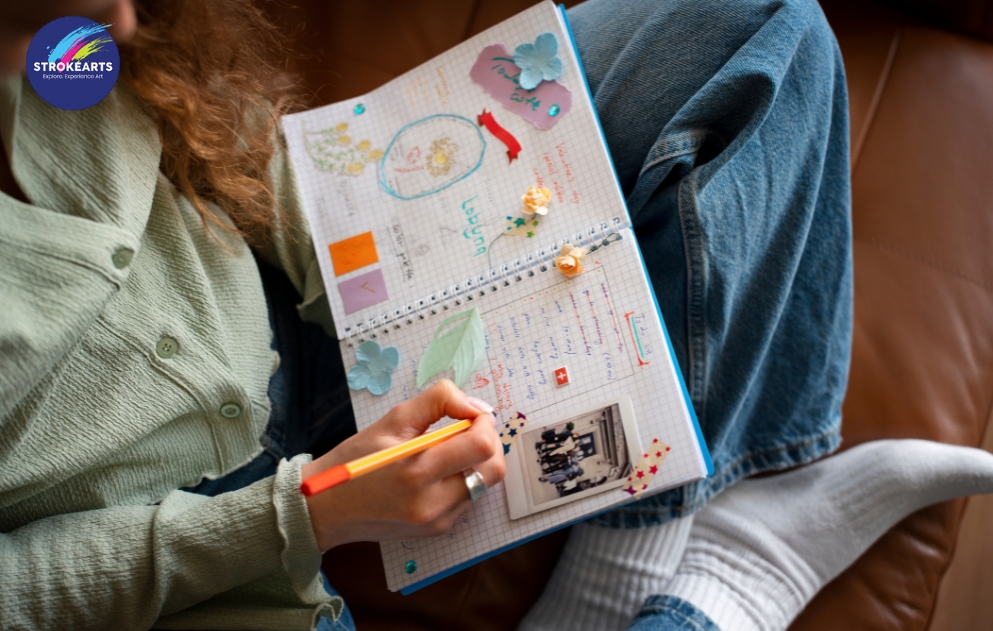A personal art journal is more than just a sketchbook. It’s a space to express your emotions, document your life, and explore creativity in a way that’s uniquely yours. Whether you enjoy painting, doodling, or writing, art journaling offers a mindful, calming experience that can boost both self-awareness and artistic confidence.
For those exploring new ways to relax or reconnect with themselves, art journaling is a perfect starting point. Many people begin this journey through workshops or art classes in Singapore, where guidance and inspiration help unlock creative potential.
What Is an Art Journal?
An art journal combines visual art with written thoughts. It’s not about making perfect pages or finished artworks. Instead, it’s about process, expression, and exploration. You can include sketches, collage, quotes, watercolors, or anything that reflects your ideas or emotions.
Unlike a regular journal, where words are the focus, an art journal lets you communicate visually. It's your personal space to play, reflect, and record life as you see it.
Why Start an Art Journal?
The benefits of art journaling go far beyond creativity. It can help:
- Reduce stress and anxiety
- Encourage mindfulness
- Develop artistic habits
- Strengthen emotional resilience
- Promote personal reflection
Many people discover these benefits after joining art classes for adults in Singapore, where journaling is often introduced as a therapeutic and expressive practice.
Step 1: Choose the Right Journal
Start by selecting a journal that suits your needs. You can choose a plain sketchbook, a bound notebook, or a mixed-media journal depending on what tools you want to use.
Tips:
- Use thick paper if you plan to paint or use markers
- Spiral-bound journals open flat and are easy to work in
- Pocket-sized notebooks are great for on-the-go sketching
Some drawing classes for adults in Singapore also provide recommended materials for beginners, making it easier to get started.
Step 2: Gather Your Tools
You don’t need expensive art supplies. Begin with the basics:
- Pencils, pens, and markers
- Watercolors or acrylic paints
- Glue and scissors
- Stickers, washi tape, or old magazines for collage
These basic tools are enough to experiment with various art journaling techniques. As you gain confidence, you can explore additional materials like stencils, stamps, or ink.
Step 3: Set an Intention
Before you begin, ask yourself what you want your journal to be. Do you want to track your mood? Explore memories? Develop a daily sketch habit?
Setting a clear intention helps you stay consistent. Some people use their journals as creative diaries, while others focus on themes like gratitude or self-care.
If you're just starting out, attending art classes for young adults can provide structure and motivation, especially if you're looking for ideas or community support.
Step 4: Try Different Art Journaling Techniques
Here are a few beginner-friendly ideas to try:
Layering
Combine colors, textures, and words to create depth and emotion.
Mixed Media Collage
Use magazine clippings, fabric, or recycled paper to build visual stories.
Watercolor Backgrounds
Start your page with a soft wash of color, then draw or write on top.
Visual Affirmations
Write empowering phrases and decorate around them with patterns or imagery.
Sketch and Reflect
Draw a quick sketch and pair it with a short journal entry about your day or feelings.
These are just a few of the many approaches taught in drawing classes for adults in Singapore, where experimentation and self-expression are encouraged.
Step 5: Create Your First Page
Start with something simple and pressure-free. Don’t worry about making it perfect. Some easy ideas:
- A mood tracker using colors or doodles
- A quote that inspires you
- A sketch of something from your day
- A list of dreams or goals
- A symbolic self-portrait using shapes or patterns
Your journal is for you. It’s a private, judgment-free space that evolves as you do.
Step 6: Build a Habit
Try to journal regularly. Even a few minutes a day or once a week can make a difference. Keep your materials accessible and allow yourself to create without expectations.
Joining community-based programs or art classes in Singapore can keep you motivated and expose you to new styles or group activities that enrich your journaling journey.
Step 7: Explore Creative Diary Ideas
Once you’ve built momentum, expand your practice with creative prompts:
- Draw your favorite memory from the week
- Use your non-dominant hand for a page
- Turn song lyrics into visual art
- Create a page inspired by your dreams
- Explore themes like nature, identity, or healing
These ideas can make your journal a powerful tool for personal expression through art.
Conclusion
An art journal is more than just a book of drawings. It’s your story in visual form—raw, emotional, and beautifully imperfect. Whether you’re a complete beginner or someone revisiting creativity after a break, art journaling offers a safe, expressive way to explore your thoughts and imagination.
If you're looking for guidance, structure, or inspiration, consider enrolling in a local program. Options like art classes for adults in Singapore or art classes for young adults often include creative journaling projects to help you find your flow and build consistency.
Start today with a blank page and see where your creativity leads you.
Read More:- Incorporating Art into Daily Routines for Cognitive Benefits





Comments